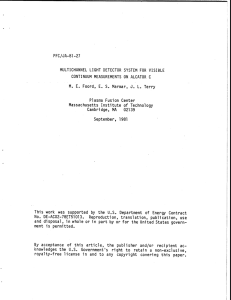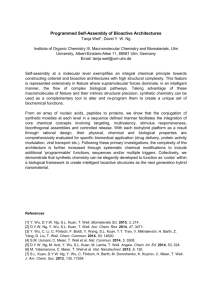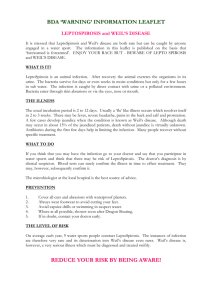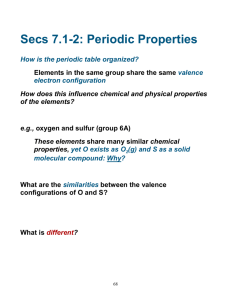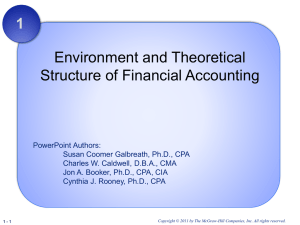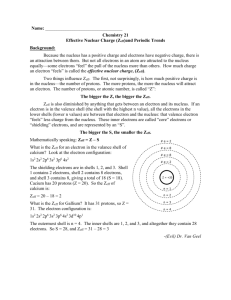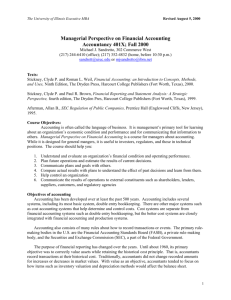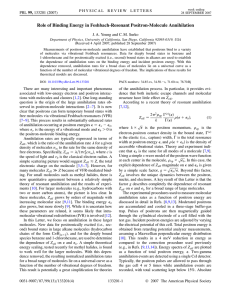MGMT 606 (2 credits)
advertisement
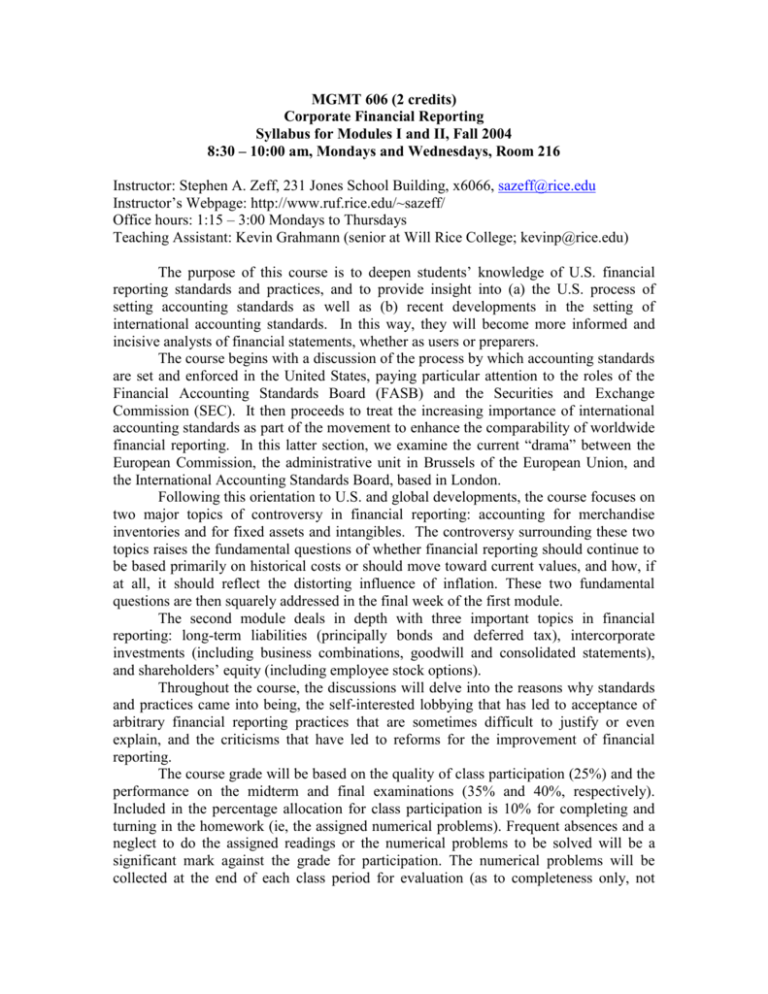
MGMT 606 (2 credits) Corporate Financial Reporting Syllabus for Modules I and II, Fall 2004 8:30 – 10:00 am, Mondays and Wednesdays, Room 216 Instructor: Stephen A. Zeff, 231 Jones School Building, x6066, sazeff@rice.edu Instructor’s Webpage: http://www.ruf.rice.edu/~sazeff/ Office hours: 1:15 – 3:00 Mondays to Thursdays Teaching Assistant: Kevin Grahmann (senior at Will Rice College; kevinp@rice.edu) The purpose of this course is to deepen students’ knowledge of U.S. financial reporting standards and practices, and to provide insight into (a) the U.S. process of setting accounting standards as well as (b) recent developments in the setting of international accounting standards. In this way, they will become more informed and incisive analysts of financial statements, whether as users or preparers. The course begins with a discussion of the process by which accounting standards are set and enforced in the United States, paying particular attention to the roles of the Financial Accounting Standards Board (FASB) and the Securities and Exchange Commission (SEC). It then proceeds to treat the increasing importance of international accounting standards as part of the movement to enhance the comparability of worldwide financial reporting. In this latter section, we examine the current “drama” between the European Commission, the administrative unit in Brussels of the European Union, and the International Accounting Standards Board, based in London. Following this orientation to U.S. and global developments, the course focuses on two major topics of controversy in financial reporting: accounting for merchandise inventories and for fixed assets and intangibles. The controversy surrounding these two topics raises the fundamental questions of whether financial reporting should continue to be based primarily on historical costs or should move toward current values, and how, if at all, it should reflect the distorting influence of inflation. These two fundamental questions are then squarely addressed in the final week of the first module. The second module deals in depth with three important topics in financial reporting: long-term liabilities (principally bonds and deferred tax), intercorporate investments (including business combinations, goodwill and consolidated statements), and shareholders’ equity (including employee stock options). Throughout the course, the discussions will delve into the reasons why standards and practices came into being, the self-interested lobbying that has led to acceptance of arbitrary financial reporting practices that are sometimes difficult to justify or even explain, and the criticisms that have led to reforms for the improvement of financial reporting. The course grade will be based on the quality of class participation (25%) and the performance on the midterm and final examinations (35% and 40%, respectively). Included in the percentage allocation for class participation is 10% for completing and turning in the homework (ie, the assigned numerical problems). Frequent absences and a neglect to do the assigned readings or the numerical problems to be solved will be a significant mark against the grade for participation. The numerical problems will be collected at the end of each class period for evaluation (as to completeness only, not correctness) by the TA. Homework submitted after the end of class (ie, after the instructor leaves the classroom) will not be accepted. Two misses of homework, regardless of reason, will be allowed without discredit. The mid-term examination will be given on a take-home basis. Completed bluebooks returned after the indicated deadline will be penalized at least a full grade point (eg, from A to B), depending on the degree of lateness. The solutions to all of the problems at the end of each chapter will be placed on reserve in the BIC following the last class period on the chapter. Required textbook: Stickney and Weil, Financial Accounting: An Introduction to Concepts, Methods, and Uses, tenth edition (Thomson/South-Western, 2003). A useful supplement for future reference is Accounting: The Language of Business tenth edition (Thomas Horton and Daughters, 1999), which contains a comprehensive glossary of accounting terms as well as an excellent annotation of the financial statements and footnotes in a recent General Electric annual report. The assigned readings other than in the textbook will be made available in the course packet. Students wishing to delve more deeply into the differences between U.S. generally accepted accounting principles (GAAP) and the statements issued by the International Accounting Standards Board (IASB) may consult a number of published works. A useful source involving a comparison between the GAAPs of the U.S., Canada, and two Latin American countries is Significant Differences in GAAP in Canada, Chile, Mexico and the United States...as of October 2002 (Canadian Institute of Chartered Accountants, 2002). I have a copy of this publication in my office. The best reference works on IASC/IASB Standards, U.S. GAAP, and the standards in other countries are the following: Cairns with Creighton and Daniels, Applying International Accounting Standards, third edition (London: LexisNexis Butterworths Tolley, 2002). Similarities and Differences: A Comparison of IFRS and US GAAP, February 2004 (PricewaterhouseCoopers). The Financial Reporting Team of Ernst & Young, International GAAP® 2005 (London: LexisNexis, 2005). Alexander and Archer (editors), European Accounting Guide, fourth edition (Gaithersburg, NY: Aspen Law & Business, 2001). Ordelheide and KPMG, Transnational Accounting, second edition (Palgrave Publishers, 2001), 3 volumes. The best Website for keeping on top of international financial reporting developments (including important financial reporting developments in the U.S.) is www.iasplus.com, maintained by Deloitte Touche Tohmatsu in Hong Kong, which is updated daily and is comprehensive and authoritative. The website of the IASB is at www.iasb.org. For future reading on developments in U.S. financial reporting, the best source is The CPA Journal, the monthly magazine of the New York State Society of Certified Public Accountants. Accounting Horizons, published quarterly by the American 2 Accounting Association, usually contains interesting Commentaries on current financial reporting policy issues. The Journal of Accountancy, the monthly magazine of the American Institute of Certified Public Accountants, is more of a how-to periodical for CPAs. The FASB’s Website is at www.fasb.org. Any student with a disability requiring accommodations in this course is encouraged to contact the instructor after class or during office hours. Additionally, students should contact the office of Disability Support Services, room 122 in the Ley Student Center. Assignments Appendices at the end of each chapter in Stickney & Weil are not assigned for reading unless they are indicated below. Bring the General Electric annual report for 2003 to class on the first day of every chapter. Aug 23 The Economic and Institutional Setting for Financial Reporting Chapter 1 and Appendix (pages 1-32) in Revsine, Collins and Johnson, Financial Reporting and Analysis (3rd edition, Prentice Hall, 2005) Zeff, “A Perspective on the U.S. Public/Private-Sector Approach to the Regulation of Financial Reporting,” Accounting Horizons, March 1995. Loomis, “Lies, Damned Lies, and Managed Earnings,” Fortune, August 2, 1999. Magrath and Weld, “Abusive Earnings Management and Early Warning Signs,” The CPA Journal, August 2002. Berkowitz and Rampell, “The Accounting Debate: Principles vs. Rules,” The Wall Street Journal, December 2, 2002. Political Influences on the U.S. Standard-Setting Process Zeff, “The Rise of ‘Economic Consequences,’” Journal of Accountancy, December 1978. Revsine, “The Selective Financial Misrepresentation Hypothesis,” Accounting Horizons, December 1991. Zeff, “How the U.S. Accounting Profession Got Where It Is Today” (Parts I and II) Accounting Horizons, September and December 2003. Aug 25 National Differences in Financial Reporting and the Emergence of International Accounting Standards Zeff, “The Coming Confrontation on International Accounting Standards,” The Irish Accounting Review (1998). Zeff, Note on International Accounting Standards (2004). Tidrick, “A Conversation with James J. Leisenring, IASB Member,” The CPA Journal, March 2002. Zeff, “‘Political’ Lobbying on Proposed Standards: A Challenge to the IASB,” Accounting Horizons, March 2002. Zeff, “U.S. GAAP Confronts the IASB: Roles of the SEC and the European Commission,” North Carolina Journal of International Law and 3 Commercial Regulation, Summer 2003. Bruce, “Global Harmony Hangs in the Balance,” Financial Times, February 23, 2004. “International Accounting: Fair’s Fair,” The Economist, March 6, 2004. Parker and Pretzlik, “‘Take It or Leave It’: New Rules Offer Harmony for Europe’s Accounting Standards, But Who Will play by Them?” Financial Times, March 31, 2004. Aug 30 Financial Reporting for Merchandise Inventories Chapter 7 in Stickney & Weil (the textbook) Biddle, “Paying FIFO Taxes: Your Favorite Charity?” Granof and Short, “For Some Companies, FIFO Accounting Makes Sense”; Biddle, “Taking Stock of Inventory Accounting Choices,” The Wall Street Journal (198182). Reproduced in Zeff & Dharan, Readings & Notes on Financial Accounting (4th edition, McGraw-Hill, 1994), pages 252-257. Note, “Chrysler’s Switch from LIFO to FIFO in 1971.” Solve problems 7.33 and 7.29 in Stickney & Weil (7 refers to the chapter number; 33 and 29 are the problem numbers in that chapter) Sep 1 Solve problems 7.38, 7.39 and 7.48 Sep 8 Financial Reporting for Long-Lived Tangible and Intangible Assets, including Impairments Chapter 8 and pages 76-80 in Stickney & Weil Solve problems 8.17 and 8.15 Sep 13 Solve problems 8.24, 8.32, 8.33 and 8.38 Note, “Depreciation Calculations” Sep 15 Financial Reporting for Relative and General Price Changes Kieso and Weygandt, Intermediate Accounting (9th edition, Wiley, 1998) (K&W), pages 1370-1381. Revsine, “Let’s Stop Eating our Seed Corn,” Harvard Business Review, JanuaryFebruary, 1981. Zeff and Dharan, “The Continuing Relevance of Constant Dollar and Current Value Accounting” (Zeff & Dharan, Readings & Notes on Financial Accounting (5th edition, McGraw-Hill, 1997). Solve problem E25-4, page 1392 (K&W) (independently derive the purchasing power loss) and Problem A (in course packet). In E25-4, assume that merchandise was purchased, sales were made, and operating expenses were incurred at the average index for the year (110). In Problem A, use the average index, 212, for interest, given that it accrues gradually throughout the year. 4 Sep 20 Solve problem E25-9, pages 1394-1395 (K&W), and Problem B (in course packet) MID-TERM EXAMINATION (take-home basis: distributed beginning at 9:30 am on Wednesday, September 22 at Delia Jennings’ cubicle in the 2nd floor faculty suite; to be returned by 4:30 pm on Friday, September 24 to same cubicle). The door to the faculty suite is open from 7 am to 5 pm. Sep 27 Financial Reporting for Long-Term Liabilities, including Bonds Payable and Deferred Tax Chapter 9 and pages 547-556 in Stickney & Weil Davidson, “Accelerated Depreciation and the Allocation of Income Taxes,” The Accounting Review, April 1958. Sep 29 Solve problems 9.19, 9.26, 9.25 and 9.29 Oct 4 Solve problems 9.42, 9.32 and 10.45 Oct 6 Financial Reporting for Marketable Securities and Investments, including Consolidated Statements Chapter 11 (include Appendices 11.1 and 11.2) in Stickney & Weil Bukics and Chapman, “The Big Splash: Goodbye, Pooling; Hello, Goodwill Impairment Testing,” The CPA Journal, March 2002. Dharan, “Magnitude of Goodwill in U.S. Corporate Financial Statements,” Zeff & Dharan, Readings & Notes on Financial Accounting (5th edition, McGraw-Hill, 1997). “A Premium of Billions Will Vanish on the Accounting Ledgers,” The New York Times, December 1998. Ascarelli and Bryan-Low, “International Body to Suggest Tighter Merger Accounting,” The Wall Street Journal, December 5, 2002. Note, “Eliminating Intercompany Sales” Note, “Minority Interest and Goodwill” Oct 11 Solve problems 11.16, 11.42, 11.47 and 11.50 (An error appears in 11.50: In Exhibit 11.18, the Investment account balance should be $80,000, not $78,000. To compensate for the additional $2,000, increase Ely’s Retained Earnings from $105,000 to $107,000.) Oct 13 Solve problems 11.18, 11.48, 11.49 and 11.52 (In 11.48, add part d: Assume that Peak bought 80% of Valley for $40,000. Give the consolidation work-sheet entry to eliminate the investment account at the end of the current year.) Oct 18 Financial Reporting for Shareholders’ Equity, including Employee Stock Options Chapter 12 and pages 266-267 in Stickney & Weil 5 Reilly, “Foreign Firms to Expense Options,” The Wall Street Journal, February 19, 2004. Michaels, “Politicians Fight US Share Options Reform,” Financial Times, March 10, 2004. Norris, “Accounting Board Wants Options to Be Reported as an Expense,” The New York Times, April 1, 2004. Wei, “What’s the Cost of a Stock Option?” The Wall Street Journal, March 4, 2004. Norris, “Wages of Bad Accounting: Bosses Got Rich While Companies Borrowed,” The New York Times, April 2, 2004. “Eshoo Criticizes Stock Options Rule,” Congresswoman Anna Eshoo Website, March 31, 2004. Bodie, Kaplan and Merton, “Options Should be Reflected in the Bottom Line,” The Wall Street Journal, August 1, 2002. Phillips, Luehlfing and Vallario, “Hazy Reporting,” Journal of Accountancy, August 2002. Solve problem 12.24 Oct 20 Solve problems 12.22, 12.35, 12.37 and 12.38 FINAL EXAMINATION (in-class examination: 9 am-12 noon, Monday, October 25) 6


